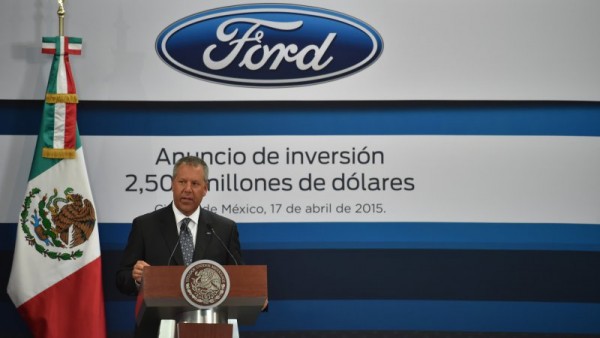In the latest development, Ford Motor Co. will build a new assembly plant in San Luis Potosí, Mexico and sharply increase factory output from that country, representing the most recent shift of investment abroad by a Detroit auto maker following the signing of a costly new labor deal.
The Wall Street Journal reports that the No. 2 light-vehicle seller in the U.S. plans to add 500,000 units of annual Mexican capacity starting in 2018, more than double what it built in 2015, according to people briefed on the plan. The plan mirrors General Motors Co. ’s $5 billion investment to double Mexican capacity by 2018.
Ford will build a new assembly complex in San Luis Potosí, and expand an existing factory near Mexico City. The moves will make room for several models, including a yet-to-be-disclosed hybrid vehicle that is described as a Toyota “Prius fighter,” and will allow Ford to focus its U.S. factories on higher-profit trucks and sport-utility vehicles.
Ford last year built 433,000 vehicles in Mexico, or 14% of its North American production.
Costs for the project likely will exceed $1 billion, people familiar with the details said, with factory construction beginning later this year. It follows a $2.5 billion investment Ford announced last spring to build an engine and a transmission plant in Mexico.
Mexico has lured tens of billions of dollars in automotive investment commitments in recent years, wooing car companies with low wages, improved logistics and an arsenal of free-trade deals. Most global auto makers have in recent years opened new assembly plants in Mexico or announced plans for one, including BMW AG, Volkswagen AG and Toyota Motor Corp. Honda Motor Co. recently began making its subcompact Fit in the country, investing $800 million in a new assembly factory. Kia Motors Co. also will open a new small-car plant in Mexico this year, the South Korean auto maker’s first in the country.
Detroit auto makers have long built cars and trucks in Mexico, but the country is looking more attractive following a new labor deal struck in November with the United Auto Workers that raises wages for U.S. factory workers. Labor rates in Mexico are roughly one-fifth of those earned by unionized workers in the U.S., a gap that is only expected to widen as UAW wages approach nearly $30 an hour in coming years, representing as much as a $10 increase for some newer hires.
Auto factories in Mexico produced 3.4 million vehicles last year, or about one-fifth of North American production, according to LMC Automotive.
Still, roughly three-quarters of Ford’s North America production is in the U.S., according to WardsAuto, and the company committed to invest $9 billion in U.S. assembly and parts factories through 2019.
Mexico auto output is poised to thrive during that time. LMC expects the industry’s Mexican production to grow 53% to 5.2 million vehicles by 2019 as the share of production in the U.S. and Canada falls. Mexico’s economy minister, Ildefonso Guajardo, said last month there would be several significant auto investments announced in the first quarter involving plants and new models but declined to elaborate on specific deals.

A Ford Focus assembly line in Michigan in 2013. Ford now intends to make the Focus in Mexico. (Photo: Jeff Kowalsky/Bloomberg News)
A separate expansion at its existing plant in Cuautitlán will boost output there by an additional 150,000 automobiles. “They’re making huge amounts of profits,” Mr. Williams said. “There is no reason mathematically to go ahead and run to countries like Mexico, Taiwan, Thailand and Vietnam.”
Mexico isn’t the only market winning new investments as Detroit looks abroad.
María Antonieta Valdez, director of industrial promotion for San Luis Potosí, said “we don’t have any official information from the company.”
One of Ford’s new facilities in Mexico will get the Focus compact car, now built by unionized workers in Michigan. The Michigan factory will shift gears in the next two years, building a new Bronco sport-utility vehicle and Ranger pickup truck—two models with fatter profit margins—according to people familiar with the plans.
Ford also plans to build two other models at the new factory, including an all-new hybrid car designed to combat Toyota’s Prius, which can run on battery power at low speeds for short distances.
At its plant in Hermosillo—opened in 1986—Ford produces two midsize sedans. The company also builds the Fiesta subcompact car in Cuautitlán in a factory more than 50 years old.
—By Christina Rogers; Dudley Althaus and Anthony Harrup contributed to this article.
Source: wsj.com



Comments are closed.